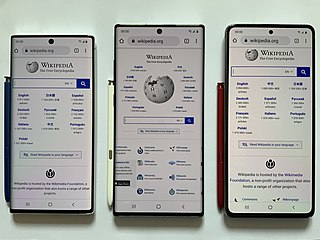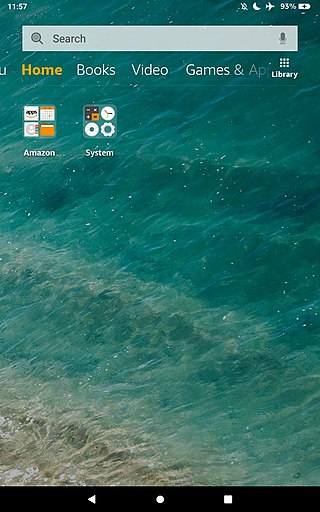
Mattel, Inc. is an American multinational toy manufacturing and entertainment company founded in Los Angeles by Harold Matson and the husband-and-wife duo of Ruth and Elliot Handler in January 1945 and headquartered in El Segundo, California. Mattel has a presence in 35 countries and territories; its products are sold in more than 150 countries. Mattel consists of three business segments: North America, International and American Girl.

LeapFrog Enterprises, Inc. is an educational entertainment and electronics company based in Emeryville, California. LeapFrog designs, develops, and markets technology-based learning products and related content for the education of children from infancy through grade school. The company was founded by Michael Wood and Robert Lally in 1994. John Barbour is the chief executive officer of LeapFrog.

View-Master is the trademark name of a line of special-format stereoscopes and corresponding View-Master "reels", which are thin cardboard disks containing seven Stereoscopic 3-D pairs of small transparent color photographs on film. It was originally manufactured and sold by Sawyer's.

InFocus Corporation is a privately owned American company based in the state of Oregon. Founded in 1986, the company develops, manufactures, and distributes DLP and LCD projectors and accessories as well as large-format touch displays, software, LED televisions, tablets and smartphones. InFocus also offers video calling services. Formerly a NASDAQ listed public company, InFocus was purchased by Image Holdings Corp., owned by John Hui, in 2009 and is now a wholly owned subsidiary headquartered in Tigard, Oregon.

Jakks Pacific, Inc. is an American company that designs and markets toys and consumer products, with a range of products that feature numerous children's toy licenses. The company is named after its founder, Jack Friedman, who had previously founded LJN and THQ and presided over the company until retiring as CEO and chairman after March 31, 2010, a month before his death on May 3, 2010.

The LeapPad is a range of tablet computers developed for children, specifically of the ages 3-9. Various models of the LeapPad have been developed by LeapFrog Enterprises since 1999.

A tablet computer, commonly shortened to tablet, is a mobile device, typically with a mobile operating system and touchscreen display processing circuitry, and a rechargeable battery in a single, thin and flat package. Tablets, being computers, have similar capabilities, but lack some input/output (I/O) abilities that others have. Modern tablets largely resemble modern smartphones, the only differences being that tablets are relatively larger than smartphones, with screens 7 inches (18 cm) or larger, measured diagonally, and may not support access to a cellular network. Unlike laptops, tablets usually run mobile operating systems, alongside smartphones.

Ideal Toy Company was an American toy company founded by Morris Michtom and his wife, Rose. During the post–World War II baby boom era, Ideal became the largest doll-making company in the United States. Their most popular dolls included Betsy Wetsy, Toni, Saucy Walker, Shirley Temple, Miss Revlon, Patti Playpal, Tammy, Thumbelina, Tiny Thumbelina, and Crissy. The company is also known for selling the Rubik's Cube.

Belkin International, Inc., is an American consumer electronics and networking company headquartered in El Segundo, California. It produces mobile and computer connectivity devices and peripherals for consumer and commercial use. These include wireless chargers, power banks, charging cables, data cables, audio and video adapters, headphones, earbuds, smart speakers, screen protectors, surge protectors, Wi-Fi routers, smart home products, electronic device sanitizers, docking stations and data hubs, network switches, KVM switches and network cables.
PocketBook is a multinational company which produces e-book readers based on E Ink technology under the PocketBook brand. The company was founded in 2007 in Kyiv, Ukraine, and its headquarters were shifted to Lugano, Switzerland in 2012. These devices enable users to browse, buy, download, and read e-books, newspapers, magazines and other digital media via wireless networking to the PocketBook Store.
The history of tablet computers and the associated special operating software is an example of pen computing technology, and thus the development of tablets has deep historical roots. The first patent for a system that recognized handwritten characters by analyzing the handwriting motion was granted in 1914. The first publicly demonstrated system using a tablet and handwriting recognition instead of a keyboard for working with a modern digital computer dates to 1956.

The Acer Iconia is a range of tablet computers from Acer Inc. of Taiwan.

The Barnes & Noble Nook is a brand of e-readers developed by American book retailer Barnes & Noble, based on the Android platform. The original device was announced in the U.S. in October 2009, and was released the next month. The original Nook had a six-inch E-paper display and a separate, smaller color touchscreen that serves as the primary input device and was capable of Wi-Fi and AT&T 3G wireless connectivity. The original Nook was followed in November 2010 by a color LCD device called the Nook Color, in June 2011 by the Nook Simple Touch, and in November 2011 and February 2012 by the Nook Tablet. On April 30, 2012, Barnes & Noble entered into a partnership with Microsoft that spun off the Nook and college businesses into a subsidiary. On August 28, 2012, Barnes and Noble announced partnerships with retailers in the UK, which began offering the Nook digital products in October 2012. In December 2014, B&N purchased Microsoft's Nook shares, ending the partnership.

Windows RT is a mobile operating system developed by Microsoft. It is a version of Windows 8 or Windows 8.1 built for the 32-bit ARM architecture (ARMv7). First unveiled in January 2011 at Consumer Electronics Show, the Windows RT 8 operating system was officially launched alongside Windows 8 on October 26, 2012, with the release of three Windows RT-based devices, including Microsoft's original Surface tablet. Unlike Windows 8, Windows RT is only available as preloaded software on devices specifically designed for the operating system by original equipment manufacturers (OEMs).

A phablet is a mobile device combining or straddling the size formats of smartphones and tablets. The word is a portmanteau of phone and tablet. The term is largely obsolete by the late 2010s, since average smartphone sizes eventually morphed into small tablet sizes, up to 6.9 inches (180 mm), with wider aspect ratios.
The Tabeo is a discontinued tablet computer developed by Toys "R" Us that runs on a version of the Android 4.0 operating system. Tabeo is officially at "End of Life" status, meaning the company is no longer providing support for the original Tabeo and Tabeo E2. Though some of the E2 devices seem to have been sold in Mexico, this seems to have happened to devices that were returned to the reseller. Tabeo is no longer fulfilling warranty repair or replacements, as the company has not produced a new device in 3 years. The company is also no longer providing assistance with any issues that may arise with the device, as the device is considerably Out of Warranty. All support has been discontinued.
It was specifically designed with children in mind, allows parents to implement parental controls, and has 50 apps pre-installed. More than 6000 other apps, all considered to be safe for children, are available on the Tabeo App Store. It has a 7-inch screen and 4 gigabytes of built-in storage space, but is capable of supporting SDHC cards with up to 32 gigabytes of space. It was released on October 21, 2012.

The Samsung Galaxy Note series was a line of high-end flagship Android phablets and smartphones developed and marketed by Samsung Electronics. The line is primarily oriented towards pen computing; all Galaxy Note models shipped with a stylus pen, called the S Pen, and incorporate a pressure-sensitive Wacom digitizer. All Galaxy Note models also include software features that are oriented towards the stylus and the devices' large screens, such as note-taking, digital scrapbooking apps, tooltips, and split-screen multitasking. The line served as Samsung's flagship smartphone model, positioned above the Galaxy S series.

Fire OS is a mobile operating system based on the Android Open Source Project (AOSP). It is developed by Amazon for their devices. Fire OS includes proprietary software, a customized user interface primarily centered on content consumption, and heavy ties to content available from Amazon's storefronts and services.
The Nokia N1 is a tablet developed by Nokia, running on Android 5.0. Unveiled on 18 November 2014, it is Nokia's first mobile device since the sale of its original mobile phone business to Microsoft earlier in the year. It was released in January 2015.

The LeapFrog Epic is an Android-based mini-tablet computer produced and marketed by LeapFrog Enterprises. Released in 2015, the Epic is LeapFrog's first device to run on Android; most of LeapFrog's mobile computing devices for children run on a customized Ångström Linux distribution.















